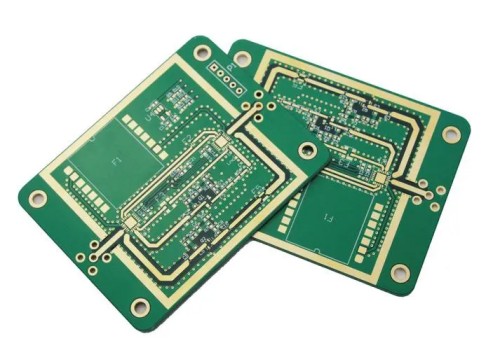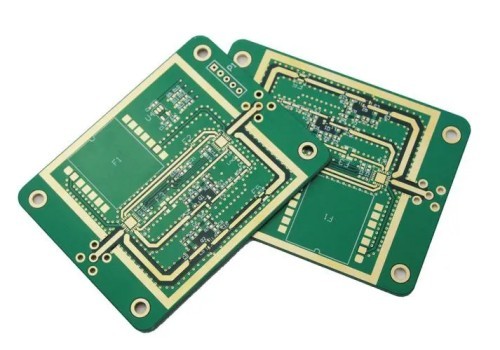Description
Rogers 4003C vs 4350B PCB

Both Rogers 4003C and 4350B are high-frequency PCB laminates of Rogers Corporation. They have some different characteristics as follows:
Dielectric constant (Dk): The dielectric constant of Rogers 4003C is 3.38 ± 0.05; the dielectric constant of Rogers 4350B is 3.48 ± 0.05. The dielectric constant affects the performance of the circuit, such as impedance matching and signal transmission speed.
Loss factor (Df): The loss factor of 4003C at 10 GHz is 0.0027; the loss factor of 4350B at 10 GHz is 0.0037. A lower loss factor means less energy loss during signal transmission.
Flame retardancy: The 4003C material itself is bromine-free and does not have the UL 94 V-0 flame retardant grade; while 4350B has passed the UL 94 V-0 certification and may have an advantage in some applications with higher requirements for fire resistance.
Processing technology: Both are similar to the standard epoxy resin/glass cloth processing technology and do not require special pretreatment processes. However, compared to traditional microwave material laminates, they are more price competitive.
Overall, Rogers 4003C is suitable for performance-sensitive and high-volume applications and has a certain price competitiveness; while 4350B has better flame retardancy while maintaining similar performance. In practical applications, the choice of which laminate to use needs to be comprehensively considered based on specific design requirements, operating frequencies, cost limitations, and requirements for characteristics such as flame retardancy.
For more detailed information, it is recommended to refer to the official materials of Rogers Corporation or consult relevant technicians. At the same time, when purchasing, it is necessary to choose a regular supplier to ensure product quality. If you have other questions about PCB laminates, please feel free to continue asking.
It should be noted that PCBs produced by different manufacturers may have differences in certain parameters. In practical applications, other factors such as the number of layers of the PCB, PCB line width and spacing, PCB drilling aperture and other processing capabilities, as well as specific product requirements and usage environments, also need to be considered. If you need more accurate and detailed technical specifications, it is recommended to refer to the product manual of the relevant manufacturer or directly contact the PCB manufacturer for consultation.
The following are some detailed technical specifications of Rogers 4003C PCB and 4350B PCB for your reference:
Rogers 4003C PCB:
- Rogers 4003C PCB Dielectric constant (Dk): 3.38 ± 0.05
- Rogers 4003C PCB Loss factor (Df @ 10GHz): 0.0027
- Rogers 4003C PCB Thermal expansion coefficient in the Z-axis (ppm/°C): 46
- Rogers 4003C PCB Glass transition temperature (Tg): High, usually greater than 280°C (536°F)
- Rogers 4003C PCB Processing technology: Similar to the ordinary epoxy resin/glass process, no special through-hole pre-treatment process is required. It can be processed using an automated process system and copper surface pre-treatment grinding equipment.
- Rogers 4003C PCB Available thicknesses: The specific available thicknesses may vary by manufacturer.
Rogers 4350B PCB:
- Rogers 4350B PCB Dielectric constant (Dk): 3.48 ± 0.05
- Rogers 4350B PCB Loss factor (Df @ 10GHz): 0.0037
- Rogers 4350B PCB Thermal expansion coefficient in the Z-axis (ppm/°C): 32
- Rogers 4350B PCB Dielectric constant tolerance: Small, with strict tolerance control
- Rogers 4350B PCB Dimensional stability: Excellent, maintaining stable electrical characteristics at different frequencies
- Rogers 4350B PCB Processing technology: Fully compatible with traditional PCB manufacturing techniques. Similar to the standard epoxy resin/glass cloth processing technology, no special pre-treatment or other pre-treatment processes for through-hole copper plating are required. The solder mask process can also use grinding plates.
- Rogers 4350B PCB Fire protection grade: Achieves UL 94 V-0
- Rogers 4350B PCB Conventional stock thicknesses: 4mil, 6.6mil, 10mil, 13.3mil, 16.6mil, 20mil, 30mil, 60mil, etc. (The specific stock thicknesses may vary by manufacturer)
What are the advantages and disadvantages of Rogers 4003C PCB and 4350B PCB respectively?
The advantages of Rogers 4003C PCB include:
- The dielectric constant is 3.38 ± 0.05, and it has good performance in high-frequency applications;
- Rogers 4003C PCB has relatively low loss characteristics;
- Rogers 4003C PCB suitable for mass production, and the cost is relatively low;
- Compatible with FR4 manufacturing process, and the Rogers 4003C PCB processing is relatively easy.
Rogers 4003C PCB disadvantages may be that it may not meet the requirements in some application scenarios with higher requirements for characteristics such as flame retardancy.
The advantages of Rogers 4350B PCB are:
- The dielectric constant is 3.48 ± 0.05, and the dielectric constant tolerance is strictly controlled;
- 4350B PCB maintains low loss characteristics (Df: 0.0037 @ 10GHz);
- 4350B PCB has CAF impedance (resistance to ion migration);
- The processing technology of 4350B PCB is similar to the standard epoxy resin/glass cloth, fully compatible with traditional PCB manufacturing techniques. Unlike PTFE laminates, it does not require special pre-treatment for plated through-holes, and the solder mask process can also use grinding plates;
- 4350B PCB price is lower than that of traditional microwave material laminates;
- 4350B PCB has passed UL 94 V-0 certification and can be applied to active devices and high-power RF designs with requirements for fire protection grades;
- 4350B PCB has good dimensional stability and can maintain stable electrical characteristics at different frequencies.
4350B PCB disadvantage may be that the cost is slightly higher than that of 4003C PCB.
However, the specific advantages and disadvantages need to be comprehensively evaluated according to the actual application scenarios and requirements. When choosing PCB laminates, multiple factors such as operating frequency, performance requirements, cost limitations, processing technology, and other special requirements need to be considered.
What are the factors influencing the prices of Rogers 4003C PCB and 4350B PCB?
The following are some factors that affect the prices of Rogers 4003C PCB and 4350B PCB:
1. Rogers 4003C PCB and 4350B PCB Raw material cost: Fluctuations in the price of Rogers laminates themselves directly affect the cost of PCBs.
2. Thickness of the laminate of rogers 4003C PCB and 4350B PCB: Thicker laminates usually have a higher cost.
3. Rogers 4003C PCB and 4350B PCB number of layers: Multilayer PCBs have a more complex manufacturing process than single-layer or double-layer PCBs, and the price is correspondingly higher.
4. Rogers 4003C PCB and 4350B PCB processing accuracy and difficulty: For example, the more precise the requirements for line width, line spacing, aperture, etc., the greater the processing difficulty and the higher the price.
5. Order quantity of Rogers 4003C PCB and 4350B PCB: Bulk orders often can obtain more favorable unit prices, while small batch orders have relatively higher prices.
6. Surface treatment process of rogers 4003C PCB and 4350B PCB: Different surface treatment methods such as immersion gold, hot air solder leveling (HASL), organic solderability preservative (OSP), etc. have different costs.
7. Special requirements: Special performance requirements such as high temperature resistance, high voltage resistance, and corrosion resistance will increase the cost.
8. Delivery time: Urgent orders may require expedited production, resulting in increased costs.
9. Rogers 4003C PCB and 4350B PCB market supply and demand relationship: When the market demand is strong and the supply is tight, the price may rise; conversely, the price may fall.
10. Manufacturer and supplier: Different manufacturers have different production costs and pricing strategies, and the channels and service costs of suppliers also affect the price. KEY TECH is an appropriate price factory.
What are the factors that affect the prices of Rogers 4003C PCB and 4350B PCB?
The following are some factors that affect the prices of Rogers 4003C PCB and 4350B PCB:
1. Raw material cost of Rogers 4003C PCB and 4350B PCB: Fluctuations in the price of Rogers laminates themselves directly affect the cost of PCBs.
2. Thickness of the laminate of Rogers 4003C PCB and 4350B PCB: Thicker laminates usually have a higher cost.
3. Rogers 4003C PCB and 4350B PCB number of layers: Multilayer PCBs have a more complex manufacturing process than single-layer or double-layer PCBs, and the price is correspondingly higher.
4. Processing accuracy and difficulty of Rogers 4003C PCB and 4350B PCB: For example, the more precise the requirements for line width, line spacing, aperture, etc., the greater the processing difficulty and the higher the price.
5. Rogers 4003C PCB and 4350B PCB Order quantity: Bulk orders often can obtain more favorable unit prices, while small batch orders have relatively higher prices.
6. Surface treatment process of Rogers 4003C PCB and 4350B PCB: Different surface treatment methods such as immersion gold, hot air solder leveling (HASL), organic solderability preservative (OSP), etc. have different costs.
7. Rogers 4003C PCB and 4350B PCB special requirements: Special performance requirements such as high temperature resistance, high voltage resistance, and corrosion resistance will increase the cost.
8. Delivery time of Rogers 4003C PCB and 4350B PCB: Urgent orders may require expedited production, resulting in increased costs.
9. Rogers 4003C PCB and 4350B PCB market supply and demand relationship: When the market demand is strong and the supply is tight, the price may rise; conversely, the price may fall.
10. Rogers 4003C PCB and 4350B PCB manufacturer and supplier: Different manufacturers have different production costs and pricing strategies, and the channels and service costs of suppliers also affect the price.
These factors work together to determine the final prices of Rogers 4003C PCB and 4350B PCB.






